Part III — Sexuality
Introduction:
Over the past two weeks, I have discussed the adult cartoon Magical Girl Friendship Squad (MGFS) and one of its main characters, Daisy, in terms of her actress Anna Akana and the character’s gender. (You can read more about the show and its approach to queerness in parts one and two.) Daisy and her roommate, Alex, become protectors to the universe-creator Nut, while battling monsters puppeted by villains Corvin and Verus. Of these five significant characters, four are, including Daisy, canonically queer. Nut and Verus once dated, and Corvin is gay. His voice actor, Matteo Lane, is also openly gay. (And we don’t know Alex’s sexuality, as we only know about her crush on an unnamed coffee guy, her romantic history unexplored. )
Today I will be focusing on Daisy’s bisexuality, which Akana confirmed on Twitter, and why many viewers interpreted Daisy as being a lesbian. For reference, Akana is bisexual, and she has mentioned her involvement with the show, tweeting, “I came on board [for] this project back when it was a proof of concept. I wasn’t just a hired [voice over] actor. I was approached specifically for the role before it was even a show.” This makes sense to me, that a bisexual woman was involved in the development of a bisexual female character. Even though MGFS doesn’t show Daisy having explicit feelings for men and women or attraction to more than one gender in general, there are several elements of MGFS that figure Daisy into bisexual history and culture. And this topic interests me because it illustrates the nuances in the question, “What even is quality bisexual representation?”
Bisexual Erasure Is Not So Magical:
MGFS has an interesting production history. While the cartoon came out in September of last year, the beginning of 2020 featured a less-polished version airing on its home channel of SyFy. This pilot series, Magical Girl Friendship Squad: Origins, features a similar premise but noticeable changes to plot, character design, and characterization, as well as casting. Akana is the only cast member to work in both versions, and arguably, Daisy changes the least in terms of characterization. For example, the second episode of Origins focuses on the two women partying with their newfound powers and the subsequent hangover, and in the process, Daisy hooks up with an unnamed woman. And that part of her character stays intact regardless of so many creative changes — Daisy being queer is written into her DNA. Over the course of MGFS’s six episodes viewers learn that Daisy has an ex-girlfriend and has slept with at least two other women, and in an alternate universe, she has a girlfriend. The sapphism is sound.
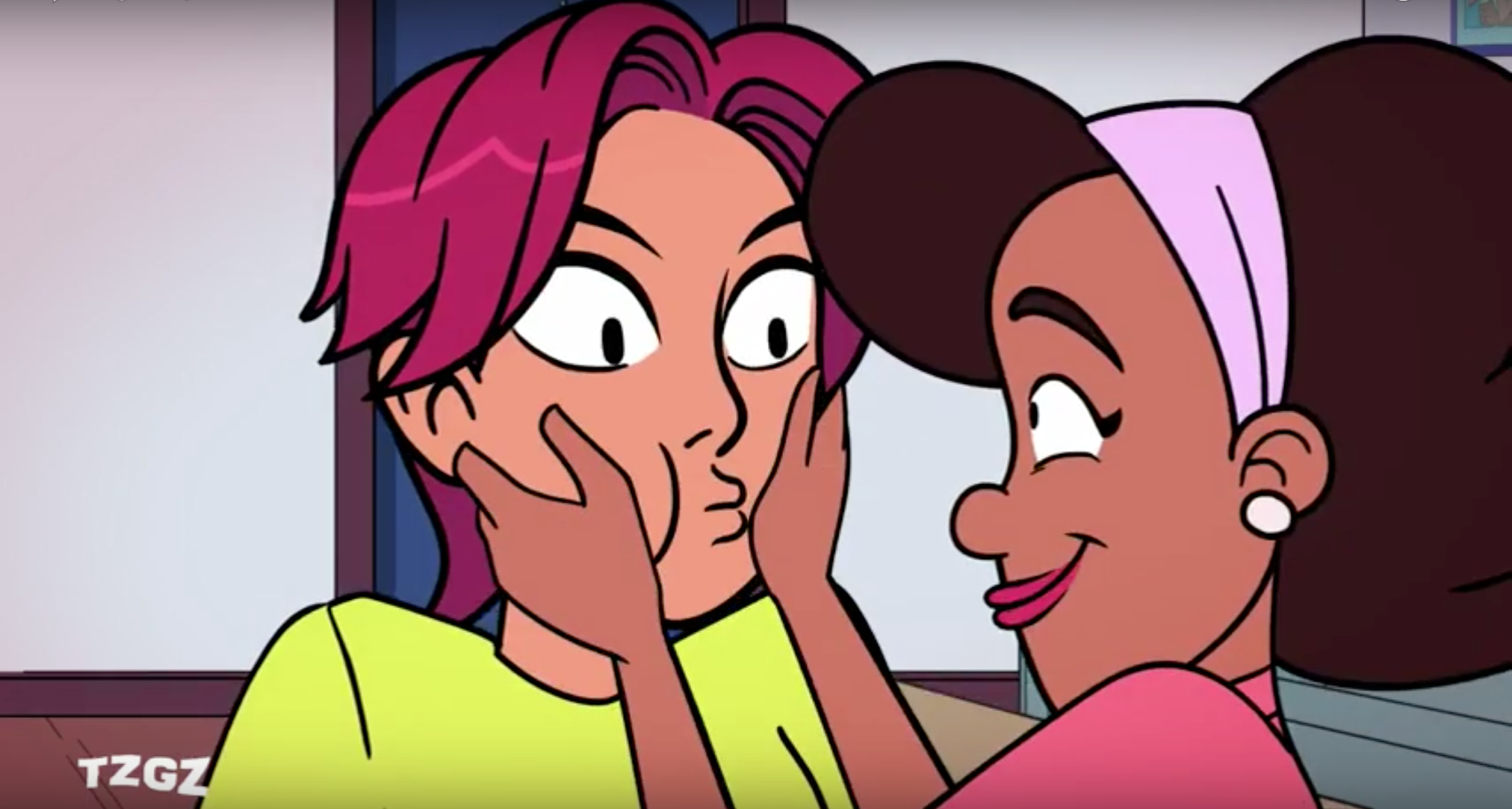
With all of that in mind, Daisy never labels her sexuality or expresses a disinterest in men. She simpy never expresses interest in them, and that is where the lesbian confusion comes in for viewers. And for viewers, Daisy’s masculine gender expression bolsters their lesbian interpretation. Female gender non-conformity has long been associated with lesbianism. Part of this mislabeling stems from the dearth of male characters in MGFS, as creator and showrunner Kelsey Stephanides set out to create an adult animated series driven by female characters. The reversed gender ratio means Daisy has less opportunities to express interest in a male character, which the short run-time compounds. MGFS has only six episodes that are approximately eleven minutes each, so we have little time to learn about any of the characters’ backstories and romantic pasts.
In my opinion though, the bulk of this issue stems from a phenomenon known as ‘compulsory monosexuality’. It’s a concept that dates back to bisexual activism since at least the 90s (James p. 220), but in a previous article, I incorrectly cited Maria San Filippo as coining the phrase (p. 10). (San Filippo believed she was coining a new term, as unfortunately bisexual theory and history are very fragmented.) Compulsory monosexuality summarizes how the straight and gay community approach bisexuality through a restricted concept of choice, expecting everyone to pick a ‘side’. A bisexual person is the unacceptable Other to a ‘monosexual’ person, regardless if the monosexual person is heterosexual or not. San Filippo writes, “Monosexuality, signaling desire enacted with partners of only one gender, is systematically reproduced by pressing social-sexual subjects to conform to either heterosexuality or homosexuality, and by keeping bisexuality (in)visible,” (p. 10).
Bisexual erasure falls under the sh*tty umbrella that is compulsory monosexuality. This experience of systemic and individual erasure relies on the assumption that sexuality falls into a rigid binary — the straight-gay dichotomy. The concept of compulsory monosexuality is often applied to real-life bisexuality, whether contemporary or historic (p. 5), but it applies to media as well. For example, one article tracked animated queer representation in the past year and included Daisy among lesbian characters, and a website that catalogues queer female characters listed her as “homosexual.” In addition the show’s Wikipedia page, up until recently, labeled Daisy a lesbian even though the page did not cite a source for this detail at all.
And that’s so indicative to me of compulsory monosexuality because Wikipedia, a site notorious for its well-sourced material and (mostly) dedicated editors, bought into that assumption. The Wikipedia article is an almost insidious form of bisexual erasure as it puts a label on a character that completely contradicts what her actress has said, an actress who is bisexual herself. The people made sure to cite the lead writer’s ambiguous statement about Daisy’s gender, while Akana’s many tweets about Daisy’s gender and sexuality seemingly went ignored.
This erasure is compounded by the fact that the crew behind MGFS also have contradictory views regarding Daisy’s queerness, as I have discussed before. Akana’s statements aren’t backed by the crew whose character she helped bring to life. Daisy’s gender, though the more visible source of discourse, is not the only thing about her in dispute. K. Downs, one of the main animators and co-lead animator directors of the series, tweeted, “Daisy is a lesbian[.] And that’s canon lol[.]” Their singular tweet, however, pales in comparison to Akana’s insistence that she played a bisexual character.
And to be clear, this is nothing wrong with the possibility of Daisy being a lesbian. Rather I am pointing out a trend that shapes viewers’ perceptions of characters and how the community around that media will aggravate any issue.
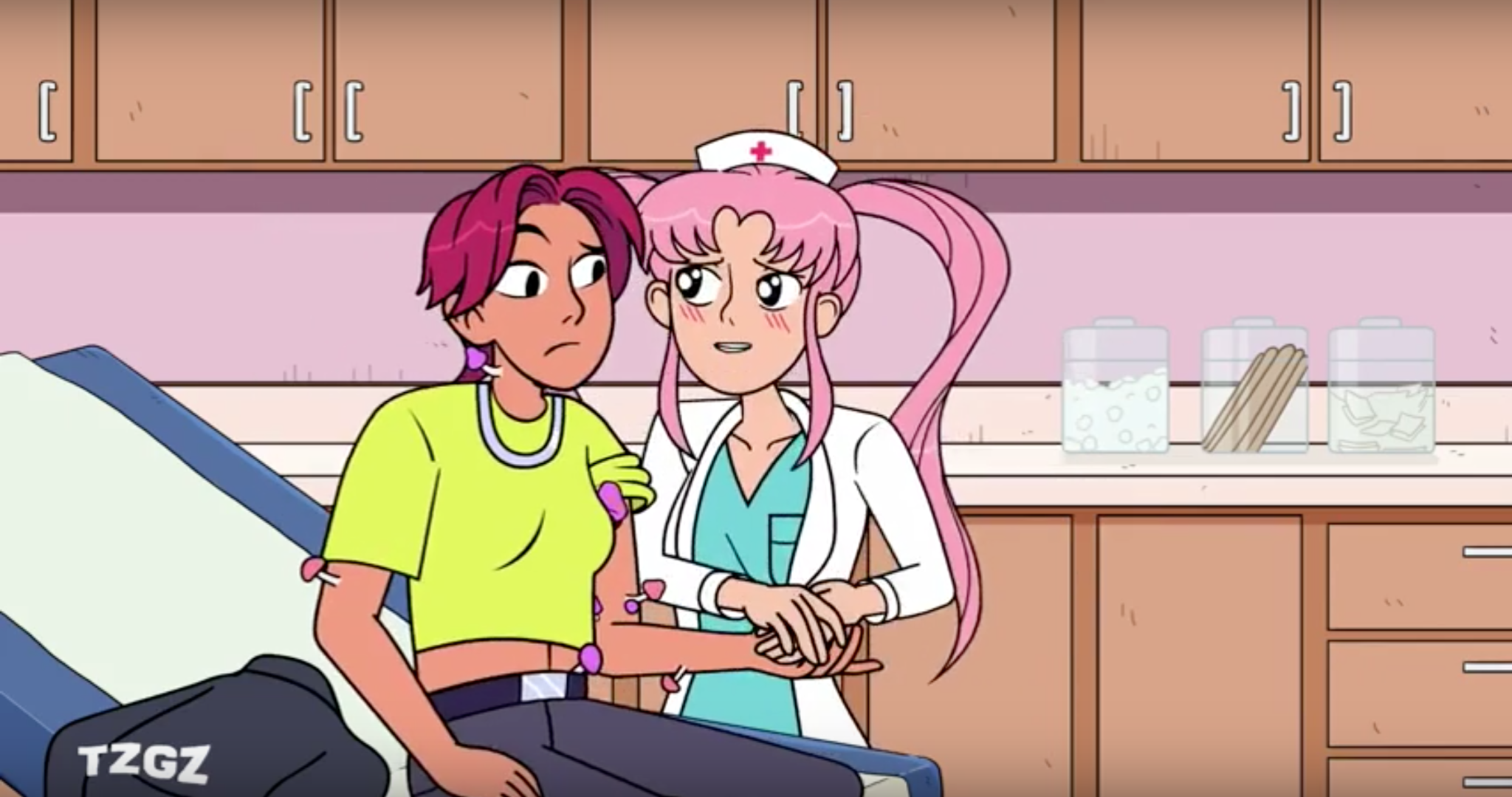
Bisexual Representation & A History of Partying:
From the first episode of MGFS, the writers establish that Daisy likes girls, while also presenting her as part of the hedonistic bisexual trope. And in my opinion, MGFS gets this trope right, stripping the harmful biphobia off a type of character who embraces a non-monogamous, pleasure-based lifestyle.
In 1×01, “My Fated Guardians,” Daisy and Alex stop by their neighborhood café and encounter two of Daisy’s hook-ups. Daisy’s past flames, as I mentioned earlier, have only been women (so far). Her ex-hook-ups are two female baristas that work at the café, and Alex quips, “Isn’t it weird for you to come here all the time when you’ve, you know, ground beans with all the baristas?” The innuendo comes across loud and queer, but what interests me is the ambiguity in this line. ‘Barista’, as used in English, remains gender neutral, so even though we only see female baristas working at the café, the writers left room for Daisy to have had a past tryst with a male barista, should the show get a season two.
Daisy as the guiltlessly promiscuous bisexual woman makes sense to me because as her degenerate lifestyle and energy are reminiscent of bisexual culture, history, and reclaimed stereotyping. She eschews being ‘basic’ and after a childhood of repression, having grown up in a cult, she refuses to capitulate to arbitrary standards of respectability.
For example, both versions of the show, Origins and MGFS, reference her having attended a sex party, and in MGFS, she has to hide several sex toys when her religious parents come to visit. While debauchery and dildos aren’t exclusive to bisexual activity, and have their own associations with lesbian culture, when the general public thinks about orgies, the image that comes to mind is a mixed-gender affair, maximizing pleasure for all partygoers.
Relatedly, when defined by a biphobic, monogamy-obsessed world, bisexual people are seen as predatory, insatiable, and indiscriminate. It’s the cheating bisexual stereotype taken to its logical extreme, and it’s a stereotype that queer creators have been grappling with for a long time. For example, the ’90s bisexual magazine Anything That Moves took its title from the stereotype that bisexual people would sleep with ‘anything that moves’ as an act of reclamation and rebellion. The Rocky Horror Picture Show similarly, back in 1973, embraced the depraved bisexual who will seduce heterosexual couples into queerness.
That being said, the hedonistic bisexual stereotype rings true in certain cases — and I’m not talking about Lord Byron. (In this case at least.)
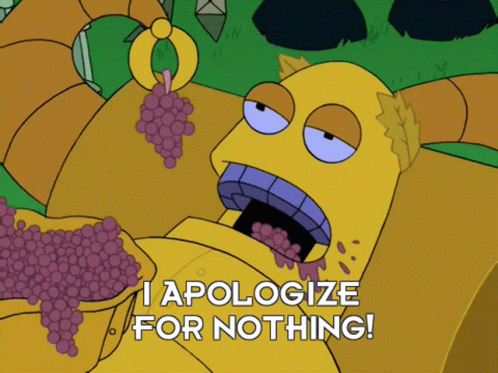
Recent American history and culture, in terms of bisexuality solidifying as a community and as an acceptable label, originate partially from mid-century communities devoted to alternative sexual practices. As countercultures contrasted against white-picket-fence America, straight researchers detailed with horror underground communities that often featured bisexual activity, such as Michael Leigh’s The Velvet Underground in 1963 and Gilbert D. Bartell’s Group Sex: A Scientist’s Eyewitness Report on the American Way of Swinging in 1971, respectively. Historian Lauren Jae Gutterman notes the prevalence of female bisexuality at swinging parties. In addition, bisexual activist Amanda Udis-Kessler confirmed this phenomenon, writing that in the ’70s, “the only people calling themselves bisexual at that point were swingers and free love advocates,” (p. 19). More so than the negative bisexual stereotypes, the character of Daisy, a bisexual woman who pursues her sexual interests with women shamelessly, comes from and inherited this cultural history.
Modern bisexual culture, being filtered through the Internet, includes memes about the ‘disaster bisexual’ type. This joke often centers around bisexuals being attracted to everyone but too awkward and flustered to make a move, or bisexuals being unable to make a decision about anything, cutsily dysfunctional. This state of being extends beyond sexuality and sexual behavior to a more general approach to life. S.E. Fleenor writes,
“Bisexual disaster energy is a term coined by bisexual+ folks to describe our experiences of being messy, fun queer people. […] [B]isexual disaster energy is the spontaneity of someone who doesn’t fit in a nice clean box. It’s a self-effacing way of saying, “We don’t have it all together, but we’re still fun — and anyway, maybe we shouldn’t have to.”
In my opinion, the ‘disaster bisexual’ is the more explicitly bi-friendly, sanitized descendant of the hedonistic bisexual trope. And Daisy embodies the ‘disaster bisexual’ to a ‘B’.
Beyond her disinterest in job monogamy and laid-back attitude, she operates on emotionality, not practicality. For instance, she chooses her most prized bong to be her magical talisman, and at one point when stressed about her lack of a career and general life choices, she paints fantasy versions of her and Alex and Nut on their living room wall. The writers pull from the history of messy bisexuals, whether consciously or not, but they do not confine Daisy to a one-dimensional interpretation of this trope. We see Daisy experience a variety of feelings related to her lifestyle choices, and though she does feel shame in relation to them, the shame is never about her intrinsic traits, like her (bi)sexuality. What she does feel ashamed of is her unemployment, and Alex quickly corrects her, reminding Daisy that capitalistic productivity doesn’t define her self-worth. Most importantly, the story does not punish her for desiring women. It is an accepted part of her character from the get-go.
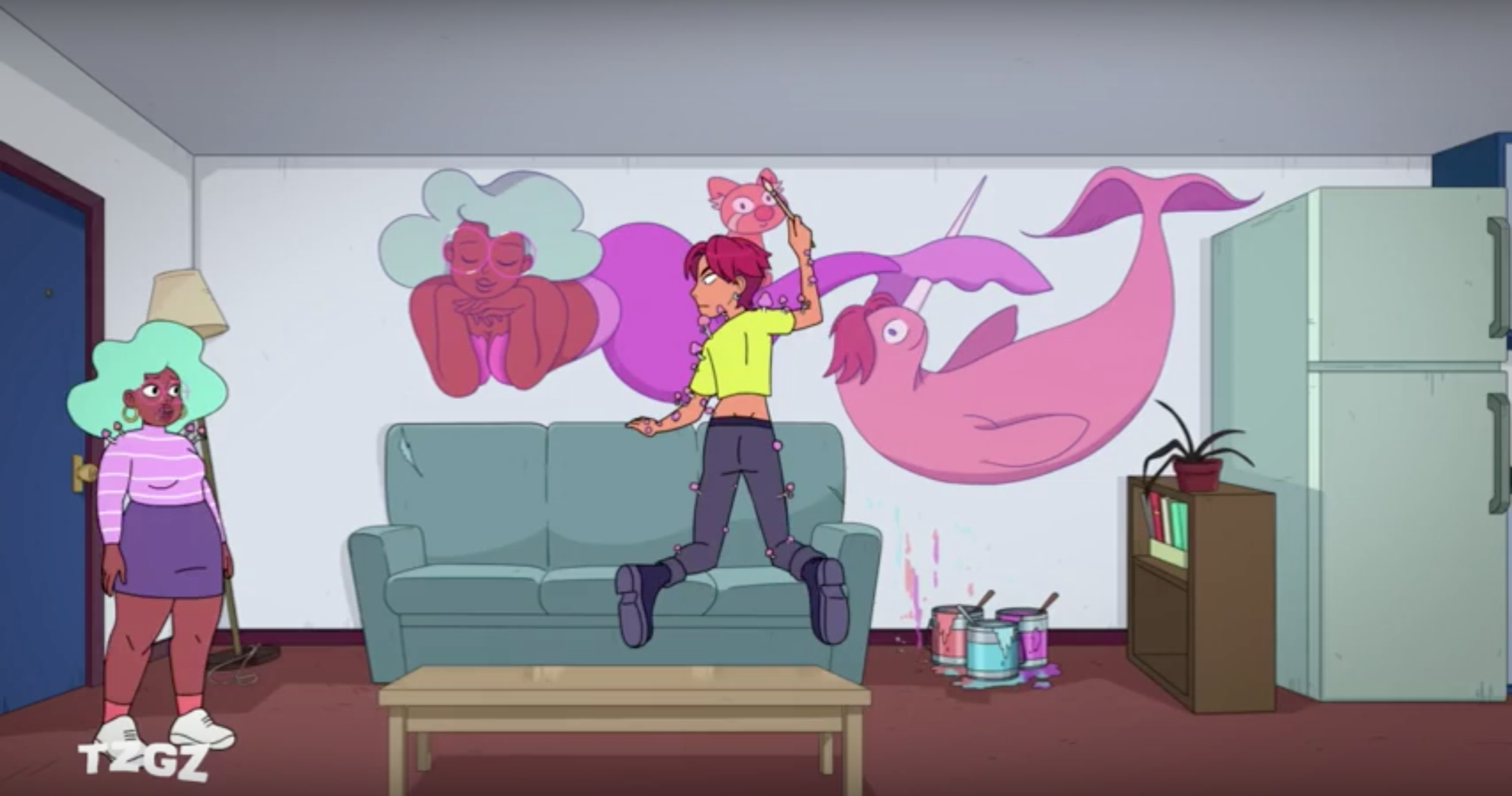
Lastly, Daisy has expressed attraction to a few real-life female celebrities throughout the show: Amelia Earhart, Gillian Anderson, and Megan Fox. All three women figure into bisexuality, whether on a public or private level. Daisy often references pop culture in MGFS, but these three women stand out due to her specific interest in them. While I’m not sure the writers intended this — and if they did, Akana could have given her input — but by having Daisy mention them, the writers further connected her to bisexual culture and history outside her sexual behavior.
Amelia Earhart, though married to a man, had a “close” relationship with Eleanor Roosevelt, the latter woman now recognized as bisexual. And rumors circulated about Earhart’s queerness throughout her lifetime (pp. 25-26) Similarly, though Gillian Anderson has not publicly labeled herself as ‘bisexual’ she falls under the broad umbrella that is the bisexual experience, once saying, “I wouldn’t discount [having a same-sex relationship], I did it before and I’m not closed to that idea. To me a relationship is about loving another human being; their gender is irrelevant.” Since The X-Files, she has been an icon and an influence on queer women, with many citing her as instrumental to their acceptance of them being queer (Howat abstract). The X-Files, which Daisy clearly adores with her obsession for Scully and writing erotic fanfiction based on the show, also falls into bisexual culture because of its equally attractive leads and whose characters were a partnership, not a male protagonist and his female love interest. It’s that bisexual gaze.
Megan Fox, unlike the other two, has gone on record using the bisexual label to describe herself. Her titular character in Jennifer’s Body, a film that has since garnered cult classic status, is also a textbook bisexual. (Jennifer’s Body is in many ways a break-up story between two bisexual female characters packaged within a feminist horror flick, the lines blurred between friendship and romance.)
Overall, Daisy succeeds as a bisexual character on a subtextual level, as MGFS portrayed her as a person and not a cartoonish stock character, fleshed-out like the flesh-and-blood bi women who have been ‘disgraceful’ and ‘shameless’ throughout history. They then bolstered this subtext by situating her within bisexual media history in a way that does not shame or villainize her sexuality.
Some Final, Dual Thoughts On Queer Rep:
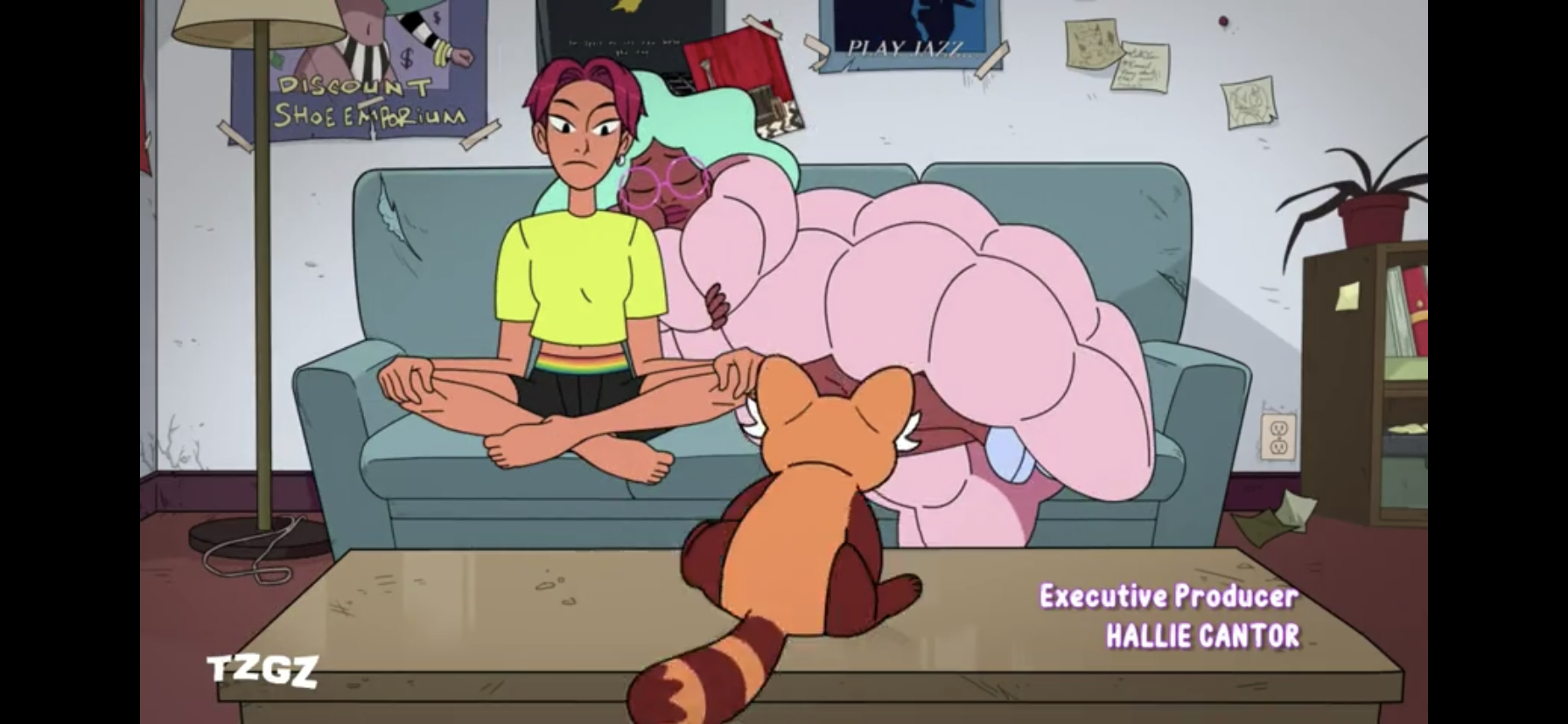
Every year, Pride month starts out with exhausting discourse about who ‘belongs’ at pride events and the stupid moral ‘think of the children’ panic that’s always plagued queer communities. And it plagues our media too, leftist fans holding media that actually centers characters like us to harsher standards than the Disney-style representation that doesn’t even attempt to try. A part of me is glad that Magical Girl Friendship Squad never achieved major mainstream recognition, even with it airing on SyFy, for this reason.
Telling stories about marginalized people, even when those characters are one hundred percent the heroes of the story and the most positive role models, remains difficult. Every storyteller must contend with the two political extremes of right-wing disgust at representation and left-wing moral Puritanism. Personally, I love the character of Daisy, and her pleasure-seeking ways, which stand as a direct defiance of her abusive parents, deeply resonated with me. Bisexual characters do not need to be suitable for a Disney Channel Original Movie (™) to be ‘good’ queer representation. That’s putting a group of people on a pedestal, and that’s infantilizing and dangerous, leading to blowback when someone inevitably ‘falls’.
Queer representation extends beyond the desexualized ‘uwu’, only-hold-hands characters. That kind of representation has its own importance and its own place within storytelling, but it should not be valorized at the expense of ‘degenerate art’. Representation aims to portray some kind of truth for real people, though not all people, hence why we need a spectrum of stories and characters. Akana understands this well, citing a sapphic threesome as important to accepting her bisexuality, the physical acts a tangible answer for an internal struggle. One of the reasons Daisy being bisexual means so much to Akana is likely because she helped to validate Akana’s own sexual experiences. Columnist David Fisher also understood this well, writing in 1991,
“Yes, we should challenge the myths of the bisexual as divided soul and the bisexual as contemporary narcissist who cannot connect deeply with others but, no, we don’t need a new myth of the bisexual positive hero who always triumphs over his limitations and lives happily ever after. There is no universal psychology that can be tacked onto bisexuals.” (p. 12)
Bisexual representation has suffered under hypersexualized, fetishized stereotypes, but that does not mean we cannot uplift non-normative, non-monogamous sexual practices. Indeed, the ‘Mother of Pride’ was a bisexual woman named Brenda Howard. She was unashamed about her experiences in sex work, and she was unapologetic about her kinky, polyamorous lifestyle.
Since the world has subjected us to predatory, chauvinistic ‘playboy’ characters — like Howard from The Big Bang Theory and Barney Stinson from How I Met Your Mother — then certainly we can handle complex disaster bisexuals who struggle with commitment while fighting monsters on the side.
With all that in mind, creators must be aware of audience perception for marginalized groups and stereotypes and tropes. Too often bisexual characters appear onscreen and never label themselves that way, and that silence contributes to bisexual erasure in general. Audiences then go a step further and preemptively, and incorrectly, refer to those characters as gay. Even when a female character expresses attraction to more than one gender, fans will call her a lesbian. I see this online all the time.
For a character like Daisy, who has only expressed attraction to women onscreen and who prefers masculine clothing, I can understand why the audience read her as a lesbian. Mae Martin summarized this aspect of compulsory monosexuality for one of their stand-up shows in 2017: “[I]f you have short hair and you mostly date girls, and you’re out, you’re in a bar, and you’re like, ‘I wanna get with that guy.’ People are like, ‘Prove it, Ellen Degeneres. We’ll believe it when we see you giving a BJ,’” (t. 0:52-1:04).
Most people do not research bisexual culture and history, and even if the writers intended for Daisy to be a bisexual hedonist and disaster, those intentions do not come across clearly. If MGFS gets a second season, the show does not need to give Daisy a male love interest or ex-flame to communicate her bisexuality. The writers can simply have the character label herself. I know that I and Akana would be very appreciative of that.
Images courtesy of Cartuna and TZGZ Productions
Have strong thoughts about this piece you need to share? Or maybe there’s something else on your mind you’re wanting to talk about with fellow Fandomentals? Head on over to our Community server to join in the conversation!

